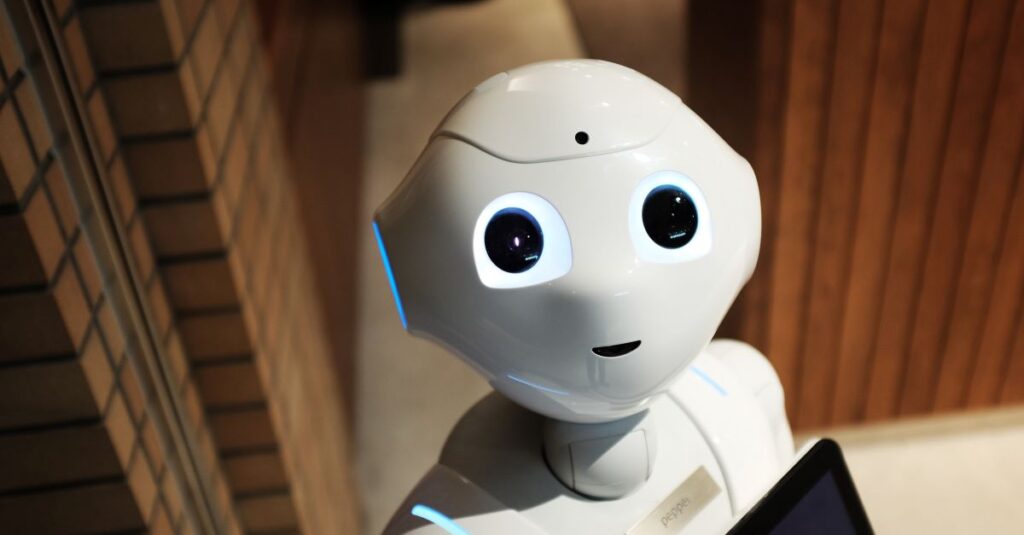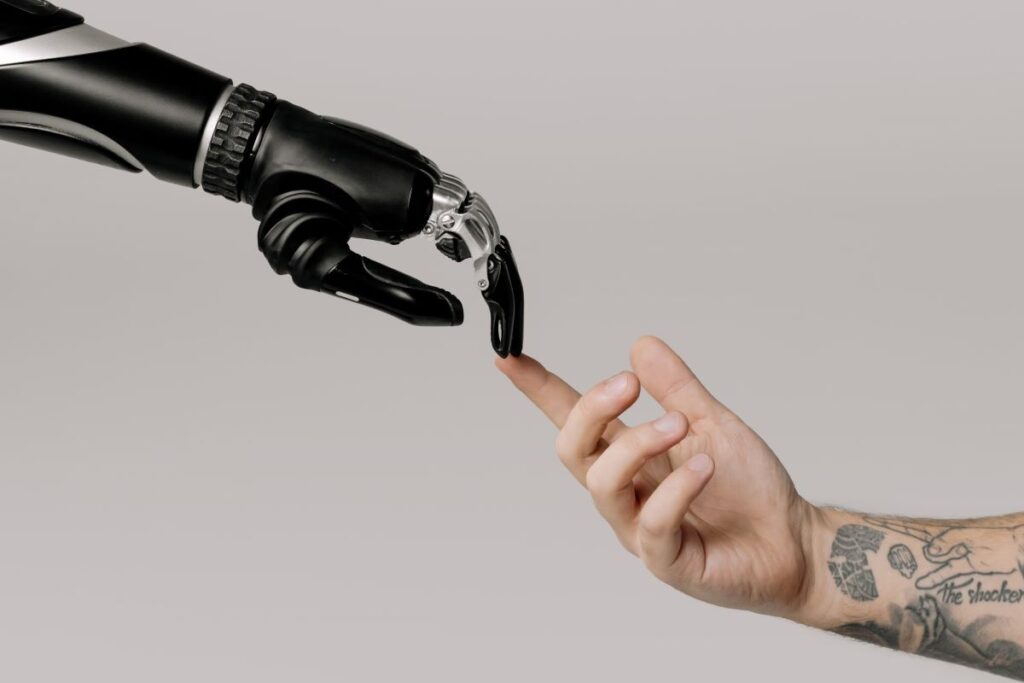Autism and AI: 7 Exciting Examples of Artificial Intelligence Support
It’s no secret that I love the notion of and learning all about examples of artificial intelligence (AI) being used today.
AI has recently emerged as a transformative force, offering unprecedented opportunities in how we learn, work, and live. I especially enjoy discovering how artificial intelligence and autism are being prepared to improve the quality of life for a growing number of people.

Autism and AI may not be a pairing that you have heard a lot about, but I think there will be many more discoveries and assessments in the future. I am happy to hear of the profound impact AI is already making in the lives of people with autism, unlocking new possibilities and revolutionizing support systems.
Autism and Artificial Intelligence (AI) is a powerful combination that can assist individuals on the autism spectrum disorder. Examples of artificial intelligence at work is that it is helping to diagnosis autism spectrum disorders, develop personalized learning and therapy, facilitate social skills development, and work with individuals with language difficulties communicate via alternative means, such as an artificial intelligence voice generator.
And that’s just for starters.
If you’re like me, you have so many artificial intelligence questions. You may also be wondering (like me) if applications like artificial intelligence for writing, artificial intelligence drawing, artificial intelligence voice generator for speech-impairments, and even artificial health tools apply to individuals on the spectrum.
The short answer is “yes.” Autism and AI technology can be paired for the betterment of individuals, and there are many examples of artificial intelligence in use that I’ve found. It’s also exciting to see that artificial intelligence for teachers to use is also being applied to a greater extent all the time. It literally can become life-altering for certain individuals with autism.
In short, artificial intelligence serves to mimic the problem-solving and decision-making capabilities of humankind through computers and machines.
RELATED: Spotlight on the Spectrum – Understanding the 3 Levels of Autism
7 Promising Examples of Artificial Intelligence Applications
Here are some tools that are being utilized with artificial intelligence and autism. These serve to help address and hopefully answer artificial intelligence questions as to whether the technology is good or bad for humankind.
Enhanced Diagnostic Precision:
Diagnosing autism spectrum disorders (ASD) can be a complex and time-consuming process, often requiring multiple assessments and evaluations.
Remember, there is no one test out there that can definitively diagnose autism. You can’t find “autism” through a blood analysis or simple screening.
However, where utilized, AI algorithms are revolutionizing this aspect of autism support, significantly enhancing diagnostic precision.
By analyzing a comprehensive range of data, including behavioral patterns, speech nuances, and facial expressions, AI systems assist clinicians in making accurate and timely diagnoses.
More accurate diagnoses are also enabling individuals to be diagnosed later in life as adults, and for findings to determine that females also have autism in greater numbers known previously. (Remember, it used to be thought of as a “male” disorder.)
The ability of AI to process vast amounts of information and detect subtle patterns allows for early identification of autism, which facilitates timely interventions and specialized support.
Early intervention is crucial in improving outcomes for individuals with autism, making AI-powered diagnosis a game-changer in the field.
Personalized Learning and Therapy:
Education and therapy play pivotal roles in the development and well-being of individuals with autism.
Traditionally, a one-size-fits-all approach was applied, often overlooking the unique needs and learning styles of individuals with autism.
However, with the arrival of AI, personalized learning and therapy have become a reality. That aspect alone brings a personalized partnership between autism and AI.
AI-powered educational platforms and AI therapy tools offer tailored experiences, catering to diverse learning styles, preferences, and paces.
Through adaptive algorithms, AI systems analyze individual progress, identifying strengths and areas for improvement, and dynamically adjusting instructional content accordingly.
Artificial intelligence for teachers to use in classrooms is something increasing in popularity, not as a replacement for teachers, but as support and an aid.
This personalized approach can foster engagement and motivation, optimizing the effectiveness and enjoyment of educational and therapeutic interventions.
Interactive applications, virtual reality simulations, and gamified learning experiences leverage AI to create immersive and stimulating environments, making learning and therapy more enjoyable and impactful for individuals with autism.
For individuals with certain learning challenges, there are applications such as artificial intelligence for writing as a support tool and artificial intelligence drawing (allowing users to draw out their needs or wants in some instances).
Facilitating Social Skills Development:
Navigating social interactions can be a significant challenge for individuals with autism. AI-based social skills training tools provide valuable assistance in this domain.
These tools utilize autism and AI algorithms to offer real-time feedback, simulated role-playing scenarios, and interpretation of social cues.
By leveraging autism and AI technology, individuals can practice and refine their social skills in a controlled and supportive environment.
The use of virtual avatars or virtual reality technology enhances the sense of immersion and enables autistic individuals to experiment with various social situations and scenarios.
The ability to receive immediate feedback and guidance empowers individuals with autism to develop appropriate social behaviors, improve communication, and enhance interpersonal skills.
Autism and AI-supported social skills training holds immense promise in facilitating meaningful social connections and fostering greater inclusion for individuals with autism. AI and physical therapy is also a great combination.
Augmentative and Alternative Communication (AAC) Solutions:
Communication difficulties are a significant aspect of autism.
Many individuals with autism face challenges in verbal communication, making it difficult to express their thoughts and needs effectively. AI-powered Augmentative and Alternative Communication (AAC) devices and applications have transformed the lives of individuals in this regard.
Examples of artificial intelligence applications include an artificial intelligence voice generator for nonverbal or limited verbal abilities like apraxia. These AI technology tools employ natural language processing algorithms, predictive text, and voice recognition to enable individuals with autism to communicate through alternative means.
By analyzing input and providing appropriate suggestions, these AI systems support individuals in expressing themselves, participating in conversations, and engaging with others more effectively.
AAC solutions powered by AI offer newfound independence, empowerment, and a voice to individuals who struggle with verbal communication.
Emotional Support Systems:
Individuals with autism often experience heightened emotional challenges, including anxiety, stress, and difficulties in emotional regulation.
AI-driven emotional support systems play a pivotal role in promoting mental well-being and emotional development for individuals with autism.
Chatbots and virtual companions equipped with emotion recognition technology provide empathetic responses, engage in meaningful conversation, and offer coping strategies.
These autism and AI technology companions serve as constant sources of support, helping individuals manage their emotions and navigate challenging situations.
By recognizing facial expressions, tone of voice, and other cues, AI companions can tailor their responses to provide appropriate emotional support. These virtual companions offer a safe space for individuals to express their feelings, practice self-regulation techniques, and learn coping strategies.
AI-powered emotional support systems hold the potential to reduce anxiety, improve emotional well-being, and enhance overall quality of life for individuals with autism.
RELATED: Do You Know Your Flavor of Autistic Spectrum Disorders?
Promoting Independence and Daily Living Skills:
AI technologies have also found applications in promoting independence and supporting individuals with autism in their daily living skills.
For instance, AI-powered smart home systems can be customized to accommodate the specific needs and preferences of individuals with autism.
These systems can automate tasks such as adjusting lighting, temperature, and reminders for daily routines, providing structure and predictability.
Additionally, examples of artificial intelligence in this area includes AI-powered wearable devices that can assist individuals in managing their personal schedules, reminders, and prompts for self-care activities.
By leveraging AI in these areas, individuals with autism can gain greater autonomy, improve their self-management skills, and enhance their overall independence.
The autism and AI relationship can go a long way toward enabling more individuals to become independent than ever before.
Data Analysis and Research:
AI’s ability to process and analyze vast amounts of data has revolutionized autism research. Autism and AI algorithms can comb through extensive datasets, identifying patterns, correlations, and trends that might not be immediately apparent to human researchers.
This capability can accelerate the discovery of new insights, improve understanding of the underlying mechanisms of autism, and inform the development of more effective interventions and treatments.
AI’s contribution to data analysis and research holds great promise in advancing our knowledge of autism and driving innovation in the field.
Addressing Artificial Intelligence Questions and Showcasing Solutions
While the potential of AI technology in supporting individuals with autism is vast, it is crucial to approach its implementation with ethical considerations in mind.
The development of AI tools and technologies should be done in close collaboration with the autism community, taking into account diverse perspectives and ensuring accessibility for all.
It is essential to address artificial intelligence questions and any autism and AI concerns regarding data privacy, security, and potential biases in AI algorithms.
By doing so, it can ensure that individuals with autism receive respect, dignity, and support throughout their AI-enabled journey.
I understand while the technology isn’t quite to this point … yet … but I wish I had an AI personal teacher when I was in school.
I believe students clearly do better when they have a personal teacher in the classroom but most schools just don’t have the resources to give a personal teacher to every student.
As a result, artificial intelligence for teachers can be a good solution. I especially wish I had a personal teacher in my math class in 6th grade.

I have previously mentioned about how my 6th grade math class was my worst school experience.
The entire class just never stopped talking, so I could never hear the teacher. As a result, I fell behind and became completely lost.
A personal AI teacher could teach me directly and I wouldn’t have to deal with other people that never knew how to be quiet.
The chaos of that particular classroom, and the overstimulation and anxiety that the circumstances caused, is something I hope no neurodiverse individuals ever have to be a part of.
So I am incredibly happy and grateful that this technology is being developed and future students can enjoy and reap the benefits of it.
Artificial intelligence is revolutionizing today’s world. It is especially incredible to see how autism and AI can align to support and empowerment of individuals on the spectrum.
From enhancing diagnostic precision to personalized learning and therapy, facilitating social skills development, augmenting communication abilities, providing emotional support, promoting independence, and advancing research, AI will be able transform lives in profound ways
As we continue to address artificial intelligence questions about how it can support neurodiversity by harness the power of AI technology, it is crucial to prioritize collaboration, inclusivity, and ethical considerations. By doing so, society can help to ensure that autism and AI align and that the technology truly enhance the quality of life and helps to provide for living your best life ever!
With the combined efforts of researchers, developers, and the autism community, we can unlock the full potential of AI, driving progress and creating a brighter future for individuals with autism and their families.
I look forward to seeing where this rapidly evolving technology goes in the future, and how I can be a part of it as part of my autism journey.
RELATED: Autism in the Future – Optimism for Improved Perception and Embracement
Autism in Adults: Living, Learning, and Overcoming Challenges for a Fulfilled Life
Autism in adults requires additional support and coping skills to achieve independence in today’s world.
Learn more about ways adults can live fulfilled lives and the challenges they face.
- 14 Practical Ways for Staying Motivated to Unlock Full Potential
- Autism and Independence: 7 Skills That Empower Individuals to Thrive
- Dangers of Social Media Addiction: How To Leave the Screens And Face the Real World
- Autism Volunteer Opportunities: 5 Ways Helping Others Fosters Acceptance
- 8 Heartfelt Ways Autism Emotional Support Animals Transform Lives
- Are You An Adult With Autism? Here Are 6 Signs
- Autism After High School: Is College the Next Step?
- Autism vs Asperger’s Syndrome: What You Need to Know
- Autism Disclosure: Is Revealing Your Disorder Helpful or Hurtful?
- Work and Autism: What Employers Should Know About Hiring People with Neurodiversity
- Drivers with Autism Can Achieve Success Behind the Wheel

 AI technologies have also found applications in promoting independence and supporting individuals with autism in their daily living skills.
AI technologies have also found applications in promoting independence and supporting individuals with autism in their daily living skills.